Composting as an Alternative for the Treatment of Solid Waste from the Kraft Pulp Industry
Abstract
1. Introduction
2. Materials and Methods
2.1. Solid Waste
2.2. Bulking Agent
2.3. Bio-Amendment
2.4. Mixtures
2.5. Batch Composting Assays
2.6. Sampling
2.7. Analytical Methods
3. Results and Discussion
3.1. Experimental Results
3.2. Experimental Dependent Variables Functions
4. Conclusions
Author Contributions
Funding
Institutional Review Board Statement
Informed Consent Statement
Data Availability Statement
Acknowledgments
Conflicts of Interest
References
- Valois, M. Paper, paperboard and wood pulp market. In UNECE/FAO Forest Products Annual Market Review, 2011–2012; UN: Geneva, Switzerland, 2011. [Google Scholar]
- Honnold, V. Developments in the Sourcing of Raw Materials for the Production of Paper. J. Int. Commer. Econ. 2009, 2, 195–219. [Google Scholar]
- Barbosa, M. The South American Pulp and Paper Industry: The Cases Brazil, Chile, and Uruguay. World For. 2012, 17, 243–283. [Google Scholar] [CrossRef]
- Seyyedalipour, S.; Kebria, D.; Malidarreh, N.; Norouznejad, G. Study of Utilization of Pulp and Paper Industry Wastes in Production of Concrete. J. Eng. Res. Appl. 2014, 4, 115–122. [Google Scholar]
- Gavrilescu, D. Solid waste generation in kraft pulp mills. Environ. Eng. Manag. J. 2004, 3, 399–404. [Google Scholar] [CrossRef]
- Hackett, G.; Easton, C.; Duff, S. Composting of pulp and paper mill fly ash with wastewater treatment sludge. Bioresour. Technol. 1999, 70, 217–224. [Google Scholar] [CrossRef]
- Gea, T.; Artola, A.; Sánchez, A. Composting of de-inking sludge from the recycled paper manufacturing industry. Bioresour. Technol. 2005, 96, 1161–1167. [Google Scholar] [CrossRef]
- Monte, M.; Fuente, E.; Blanco, A.; Negro, C. Waste management from pulp and paper production in the European Union. Waste Manag. 2009, 29, 293–308. [Google Scholar] [CrossRef]
- Gopinathan, M.; Thirumurthy, M. Evaluation of Phytotoxicity for Compost from Organic Fraction of Municipal Solid Waste and Paper & Pulp Mill Sludge. Environ. Res. Eng. Manag. 2012, 1, 47–51. [Google Scholar] [CrossRef]
- Cherian, C.; Siddiqua, S. Pulp and Paper Mill Fly Ash: A Review. Sustainability 2019, 11, 4394. [Google Scholar] [CrossRef]
- Zawadzińska, A.; Salachna, P.; Nowak, J.S.; Kowalczyk, W.; Piechocki, R.; Łopusiewicz, Ł.; Pietrak, A. Compost Based on Pulp and Paper Mill Sludge, Fruit-Vegetable Waste, Mushroom Spent Substrate and Rye Straw Improves Yield and Nutritional Value of Tomato. Agronomy 2022, 12, 13. [Google Scholar] [CrossRef]
- Zambrano, M.; Parodi, V.; Gallardo, F.; Vidal, G. Characterization of dregs and grits from pulp Kraft mill: Study for its application to acid soils. Afinidad 2003, 60, 16–25. [Google Scholar]
- Zambrano, M.; Parodi, V.; Baeza, J.; Vidal, G. Acids soils’ pH and nutrient improvement when amended with inorganic solid wastes from kraft mill. J. Chil. Chem. Soc. 2007, 52, 1088–1091. [Google Scholar] [CrossRef]
- Żołnowski, A.C.; Sądej, W.; Suski, M.S.; Wyrwas, A.; Skrocki, D. Impact of paper mill waste on physicochemical properties of soil, crop yield, and chemical composition of plants. CLEAN Soil Air Water 2019, 47, 1900080. [Google Scholar] [CrossRef]
- Bajpai, P. Management of Pulp and Paper Mill Waste; Springer: Patiala, India, 2015. [Google Scholar] [CrossRef]
- Rodríguez-Luna, D.; Vela, N.; Alcalá, F.J.; Encina-Montoya, F. The environmental impact assessment in Chile: Overview, improvements, and comparisons. Environ. Impact Assess. Rev. 2021, 86, 106502. [Google Scholar] [CrossRef]
- Campbell, A.; Folk, R.; Tritepi, R. Wood ash as an amendment in municipal sludge and yard waste composting process. Compost Sci. Util. 1997, 5, 62–73. [Google Scholar] [CrossRef]
- Saeli, M.; Senff, L.; Tobaldi, D.M.; La Scalia, G.; Seabra, M.P.; Labrincha, J.A. Innovative Recycling of Lime Slaker Grits from Paper-Pulp Industry Reused as Aggregate in Ambient Cured Biomass Fly Ash-Based Geopolymers for Sustainable Construction Material. Sustainability 2019, 11, 3481. [Google Scholar] [CrossRef]
- Zambrano, M.; Freer, J.; Villarroel, M.; Vidal, G.; Baeza, J. Using a second order polynomial model to determined the optimum dregs/bark ratio for industrial-biosolid composting: The inicial conditioning stage. Waste Manag. Res. 2007, 25, 319–326. [Google Scholar] [CrossRef]
- Jordan, M.; Sánchez, M.; Padilla, L.; Céspedes, R.; Osses, M.; González, B. Kraft mill residues effects on Monterrey pine growth and soil microbial activity. J. Environ. Qual. 2002, 31, 1004–1009. [Google Scholar] [CrossRef]
- Jordan, M.; Rodríguez, E. Effect of solid residues from the cellulose industry on plant growth. J. Plant Nutr. Soil Sci. 2004, 167, 351–356. [Google Scholar] [CrossRef]
- Davis, C.; Donkin, C.; Hinch, S.; Germishuizen, P. Changes in microbial population numbers during the composting of pine bark. Bioresour. Technol. 1992, 39, 85–92. [Google Scholar] [CrossRef]
- Liang, C.; Das, K.; McClendon, R. The influence of temperature and moisture contents regimes on the aerobic microbial of a biosolid composting blend. Bioresour. Technol. 2003, 86, 131–137. [Google Scholar] [CrossRef] [PubMed]
- Lynch, D.; Voroney, R.; Warman, P. Use of 13C and 15N natural abundance techniques to characterize carbon and nitrogen dynamics in composting and in compost-amended soils. Soil Biol. Biochem. 2006, 38, 103–114. [Google Scholar] [CrossRef]
- Levy, S.; Taylor, B. Effects of pulp mill solids and three compost on early growth tomatoes. Bioresour. Technol. 2003, 89, 279–305. [Google Scholar] [CrossRef] [PubMed]
- Lei, F.; VanderGheyns, J. The effect of microbial inoculation and pH on microbial community structure changes during composting. Process Biochem. 2000, 35, 923–929. [Google Scholar] [CrossRef]
- Mondini, C.; Fornasier, F.; Sinicco, T. Enzymatic activity as a parameter for the characterization of the composting process. Soil Biol. Biochem. 2004, 36, 1587–1594. [Google Scholar] [CrossRef]
- Vuorinen, A. Effect of the bulking agent on acid and alkaline phosphomonoesterase and ß-D-glucosidase activities during manure composting. Bioresour. Technol. 2000, 75, 139–148. [Google Scholar] [CrossRef]
- Ryckeboer, J.; Mergaert, J.; Coosemans, J.; Deprins, K.; Swings, J. Microbiological aspects of biowaste during composting in monitored compost bin. J. Appl. Microbiol. 2003, 94, 127–137. [Google Scholar] [CrossRef] [PubMed]
- Nakamata, K.; Ohi, H. Examination of polychlorinated dibenzo-p-dioxins and polychlorinated dibezofurans in process water of kraft pulp bleaching mill using chlorine dioxide from the aspect of environmental water quality. J. Wood Sci. 2003, 49, 525–530. [Google Scholar] [CrossRef]
- Hough, G. Chemical Recovery in the Alkaline Pulping Process; Tappi Press: New York, NY, USA, 1985; p. 330. [Google Scholar]
- Zambrano, M.; Pichún, C.; Alvear, M.; Villarroel, M.; Velásquez, I.; Baeza, J.; Vidal, G. Dreg effect on secondary sludge composting from Kraft pulp mill wastewater treatment plant. Bioresour. Technol. 2010, 101, 1028–1035. [Google Scholar] [CrossRef]
- Zar, J. Biostatistical Analysis, 4th ed.; Prentice Hall: Hillsdale, NJ, USA, 1999; pp. 180–195. [Google Scholar]
- Guo, R.; Li, G.; Jiang, G.; Schuchardt, F.; Chen, T.; Zhao, Y.; Shen, Y. Effect of aeration rate, C/N ratio and moisture content on the stability and maturity of compost. Bioresour. Technol. 2012, 112, 171–178. [Google Scholar] [CrossRef]
- Díaz, M.; Eugenio, M.; Jiménez, L.; Madejón, E.; Cabrera, F. Modelling vinasse/cotton waste ratio incubation for optimum composting. Chem. Eng. J. 2003, 93, 233–240. [Google Scholar] [CrossRef]
- Chang, J.; Tsai, J.; Wu, K. Thermophilic composting of food waste. Bioresour. Technol. 2006, 97, 116–122. [Google Scholar] [CrossRef]
- Komilis, D.; Ham, R. Carbon dioxide and ammonia emissions during composting of mixed paper, yard waste and food waste. Waste Manag. 2006, 26, 62–70. [Google Scholar] [CrossRef]
- Sundberg, C.; Jönsson, H. Process inhibition to organic acids in fed-batch composting of food waste-influence of starting culture. Biodegradation 2005, 16, 205–213. [Google Scholar] [CrossRef]
- Jackson, M.; Line, M. Composting pulp and paper mill sludge—Effect of temperature and nutrient addition method. Compost Sci. Util. 1997, 5, 74–81. [Google Scholar] [CrossRef]
- Ferraz, A.; Parra, C.; Freer, J.; Rodríguez, J.; Baeza, J. Occurrence of iron-reducing compounds in biodelignified “palo podrido” wood samples. Int. Biodeterior. Biodegrad. 2001, 47, 203–208. [Google Scholar] [CrossRef]
- Wang, P.; Changa, C.; Watson, M.; Dick, W.; Chen, Y.; Hoitink, H. Maturity indices for composted dairy and pig manures. Soil Biol. Biochem. 2004, 36, 767–776. [Google Scholar] [CrossRef]
- Nannipieri, P.; Alef, K. Methods in Applied Soil Microbiology and Biochemistry; Harcourt Brace Company Publishers: San Diego, CA, USA, 1998; pp. 376–387. [Google Scholar]
- Saviozzi, A.; Cardelli, R.; N’kou, P.; Levi-Minzi, R.; Riffaldi, R. Soil biological activity as influenced by green waste compost and cattle manure. Compost Sci. Util. 2006, 14, 54–58. [Google Scholar] [CrossRef]
- Syamsiyah, J.; Sunarminto, B.H.; Hanudin, E.; Widada, J.; Mujiyo. Carbon dioxide emission and carbon sequestration potential in Alfi sol. Bulg. J. Agric. Sci. 2019, 25, 42–48. [Google Scholar]
- Saviozzi, A.; Cardelli, R.; Levi-Minzi, R.; Riffaldi, R. Evolution of Biochemical Parameters during Composting of Urban Wastes. Compost. Sci. Util. 2004, 12, 153–160. [Google Scholar] [CrossRef]
- Instituto Nacional de Normalización. Norma Chilena N°2880. Compost—Clasificación y Requisitos; Gobierno de Chile: Santiago, Chile, 2004. [Google Scholar]
- Kulku, R.; Yaldiz, O. Determination of aeration rate and kinetics of composting some agricultural wastes. Bioresour. Technol. 2004, 93, 49–57. [Google Scholar] [CrossRef] [PubMed]
- Ekinci, K.; Keener, H.; Akbolat, D. Effects of feedstock, airflow rate and recirculation ratio on performance of composting systems with air recirculation. Bioresour. Technol. 2006, 97, 922–932. [Google Scholar] [CrossRef]
- Gattinger, A.; Bausenwein, U.; Bruns, C. Microbial biomass and activity in compost of different composition and age. J. Plant Nutr. Soil Sci. 2004, 167, 556–561. [Google Scholar] [CrossRef]
- Brewer, L.; Sullivan, D. Maturity and stability evaluation of composted yard trimmings. Compost Sci. Util. 2003, 2, 96–112. [Google Scholar] [CrossRef]
- Haug, R. The Practical Handbook of Compost Engineering; Lewis Publishers: New York, NY, USA, 1993; pp. 35–65. ISBN 0-87371-373-7. [Google Scholar]
- Charest, M.; Antoun, H.; Beauchamp, C. Dynamics of water-soluble carbon substances and microbial populations during the composting of de-inking paper sludge. Bioresour. Technol. 2004, 91, 53–67. [Google Scholar] [CrossRef]
- Hellmann, B.; Zelles, L.; Palojärvi, A.; Bai, Q. Emission of Climate-Relevant Trace Gases and Succession of Microbial Communities during Open-Windrow Composting. Appl. Environ. Microbiol. 1997, 63, 1011–1018. [Google Scholar] [CrossRef] [PubMed]
- Zucconi, F.; Pera, A.; Forte, M.; De Bertoldi, M. Evaluating toxicity of immature compost. Biocycle 1981, 22, 54–57. [Google Scholar]
- Gabhane, J.; Prince William, S.; Bidyadar, R.; Bhilawe, P.; Annand, D. Additives aided composting of green waste: Effects on organic matter degradation, compost maturity, and quality of the finished compost. Bioresour. Technol. 2012, 114, 382–388. [Google Scholar] [CrossRef]
- Raut, M.; Prince, S.; Bhattacharyya, J.; Chakrabarti, T.; Devotta, S. Microbial dynamics and enzyme activities during rapid composting of municipal solid waste—A compost maturity analysis perspective. Bioresour. Technol. 2008, 99, 6512–6519. [Google Scholar] [CrossRef] [PubMed]
- Keeling, A.; Cater, G.; Cook, J.; Wilcox, A. Application of glucose at low concentrations to grass swards in waste-derived compost can significantly increase long-term yields. Plant Soil 1996, 184, 117–121. [Google Scholar] [CrossRef]
- Mondini, C.; Cayuela, M.; Sánchez-Monedero, M.; Roig, A.; Brookes, P. Soil microbial biomass activation by trace amounts of readily available substrate. Biol. Fertil. Soils 2006, 42, 542–549. [Google Scholar] [CrossRef]
- Ezelin, K.; Brun, G.; Kaemmerer, M.; Revel, J. Glucose influence on the asymbiotic nitrogen fixation during lignocellullosic waste composting. In The Science of Composting; de Bertoldi, M., Sequi, P., Lemmes, B., Papi, T., Eds.; Springer: Dordrecht, The Netherlands, 1996; pp. 137–148. [Google Scholar]
- Turner, T.; Wheeler, R.; Oliver, I.W. Evaluating land application of pulp and paper mill sludge: A review. J. Environ. Manag. 2022, 317, 115439. [Google Scholar] [CrossRef] [PubMed]
- Pinto-Morales, F.; Retamal-Salgado, J.; Lopéz, M.D.; Zapata, N.; Vergara-Retamales, R.; Pinto-Poblete, A. The Use of Compost Increases Bioactive Compounds and Fruit Yield in Calafate Grown in the Central South of Chile. Agriculture 2022, 12, 98. [Google Scholar] [CrossRef]

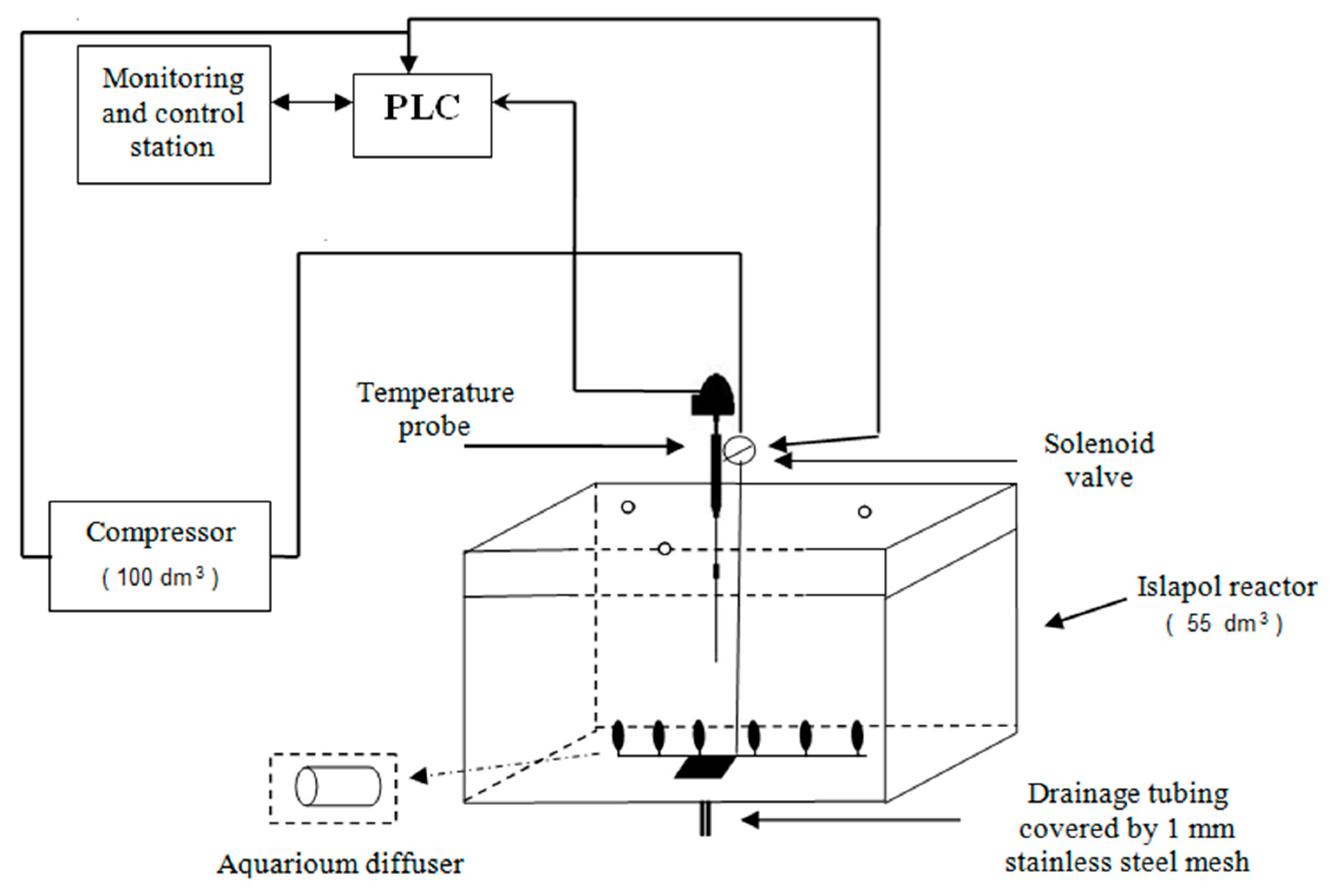
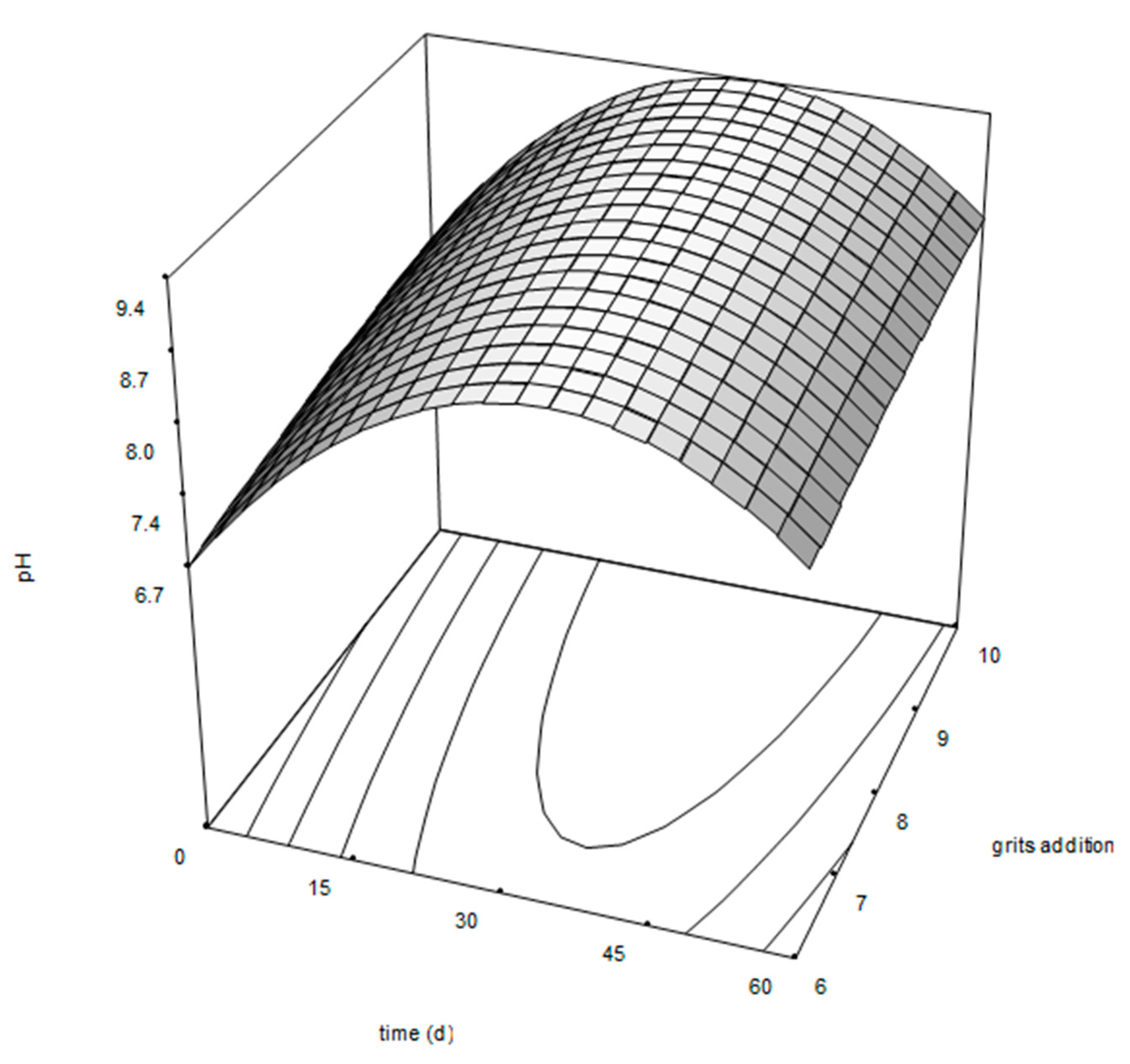
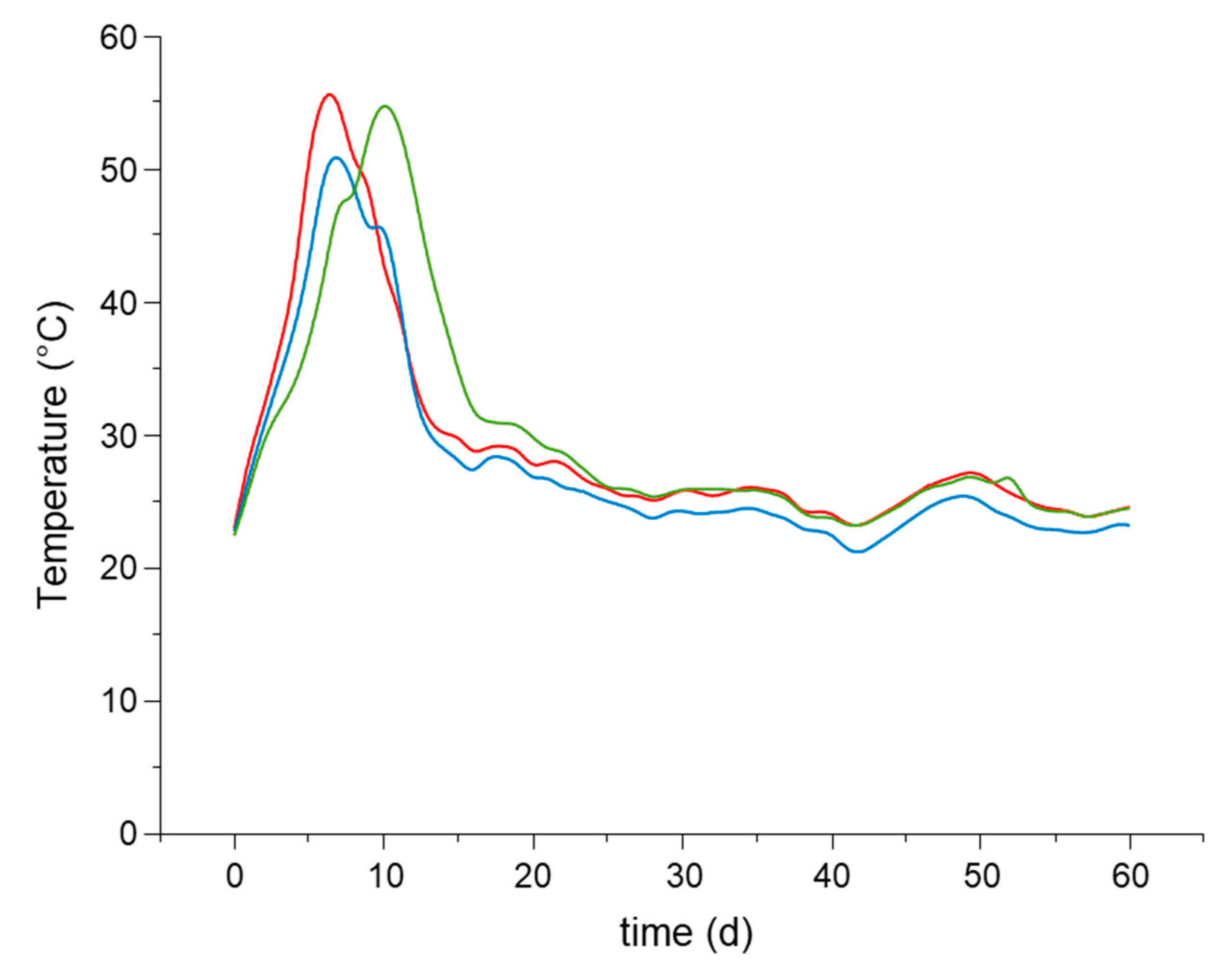
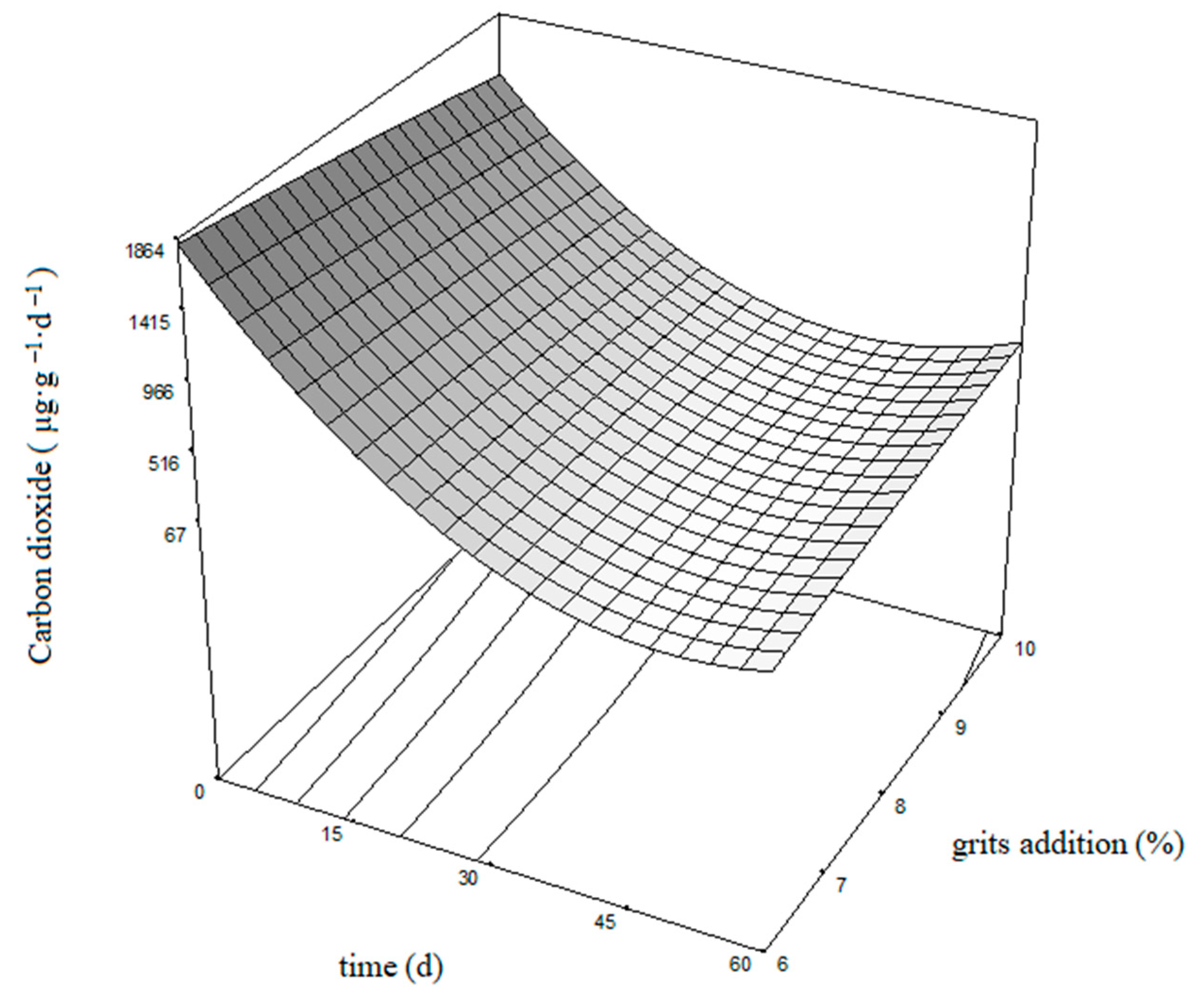
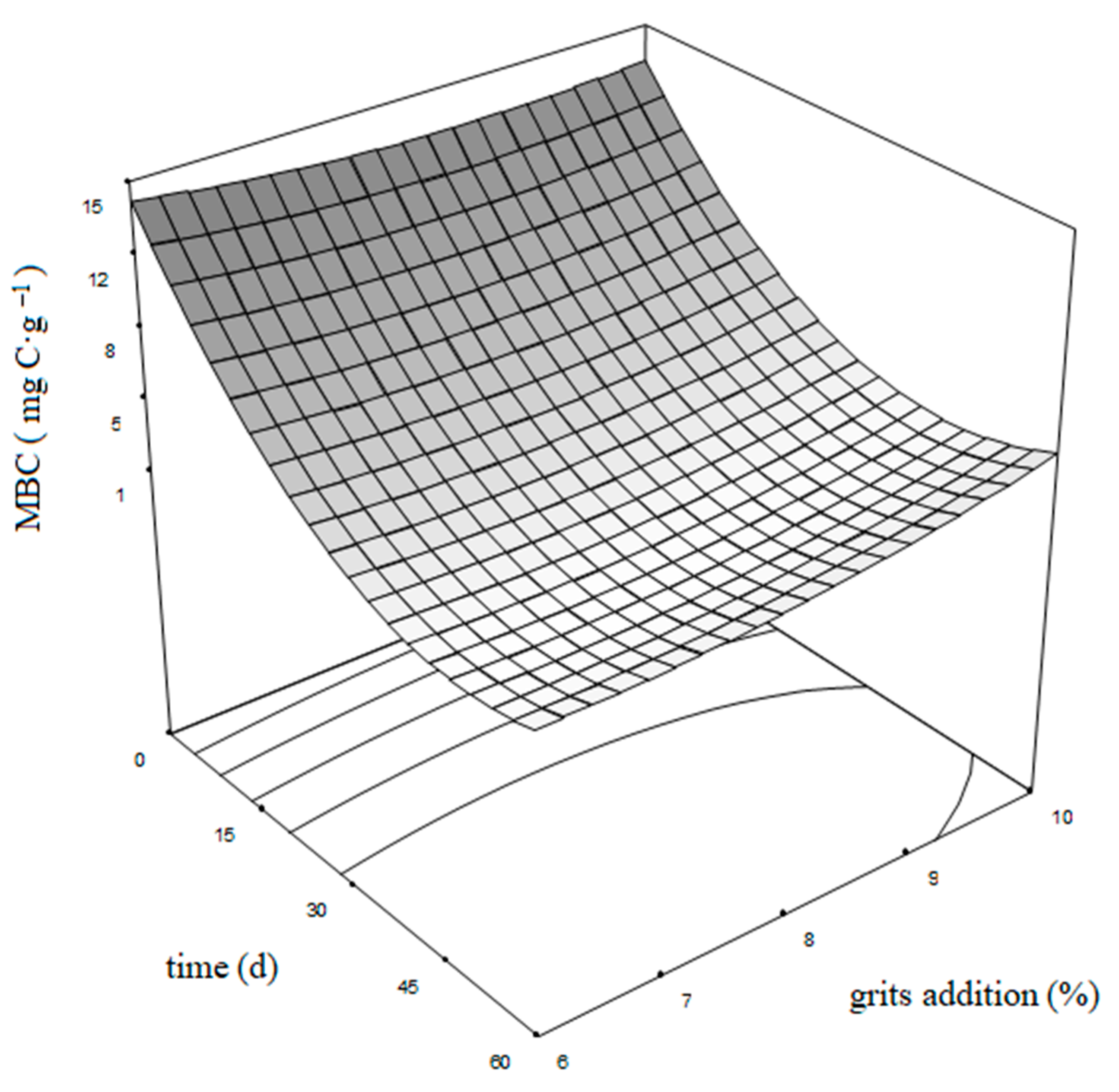
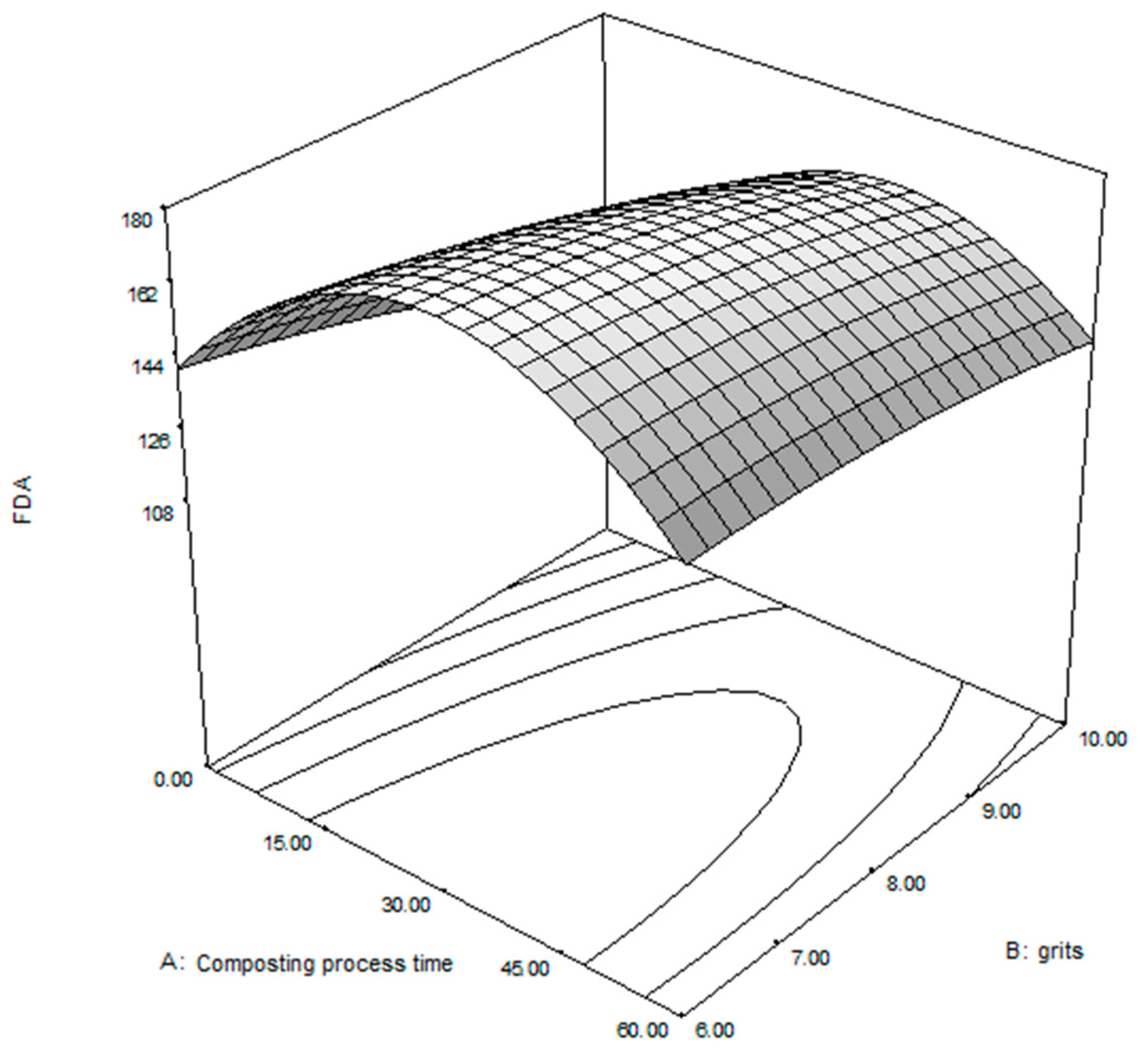
| Parameter | Units | Grits 1 |
|---|---|---|
| Humidity (%) | (%w/w ±RSD) | 7.60 ± 0.1 |
| N-total | (%w/w ±RSD) | <0.2 |
| Phosphorus | (%w/w ±RSD) | 0.74 ± 0.4 |
| Potassium | (%w/w ±RSD) | 0.14 ± 0.1 |
| Calcium | (%w/w ±RSD) | 37.50 ± 2.3 |
| Magnesium | (%w/w ±RSD) | 0.34 ± 0.3 |
| Sodium | (%w/w ±RSD) | 1.42 ± 0.1 |
| Sulfur | (%w/w ±RSD) | 1.20 ± 1.3 |
| Aluminum | (%w/w ±RSD) | 0.14 ± 0.9 |
| Zinc | (%w/w ±RSD) | 0.0019 ± 0.1 |
| Copper | (%w/w ±RSD) | 0.0021 ± 0.3 |
| Iron | (%w/w ±RSD) | 0.018 ± 1.9 |
| Manganese | (%w/w ±RSD) | 0.0029 ± 0.8 |
| Boron | (%w/w ±RSD) | 0.00053 ± 0.9 |
| Organic matter | (%w/w ±RSD) | 0.12 ± 3.3 |
| pH | 12.7 |
| Batch Experiment | Days | Grits Added G, % | pH | CO2-C 1 | MBC 2 | FDA 3 |
|---|---|---|---|---|---|---|
| 1 | 0 | 6 | 6.7 | 1860 | 15 | 137 |
| 2 | 60 | 6 | 8.9 | 195 | 2 | 145 |
| 3 | 0 | 10 | 7.3 | 1386 | 14 | 108 |
| 4 | 60 | 10 | 9.3 | 364 | 4 | 141 |
| 5 | 0 | 8 | 7.1 | 1699 | 12 | 131 |
| 6 | 60 | 8 | 9.4 | 265 | 3 | 145 |
| 7 | 30 | 6 | 8.9 | 265 | 3 | 185 |
| 8 | 30 | 10 | 9.3 | 384 | 4 | 156 |
| 9 | 30 | 8 | 9.1 | 264 | 3 | 171 |
| 10 | 30 | 8 | 9.1 | 362 | 3 | 170 |
| 11 | 30 | 8 | 9.0 | 364 | 3 | 175 |
Disclaimer/Publisher’s Note: The statements, opinions and data contained in all publications are solely those of the individual author(s) and contributor(s) and not of MDPI and/or the editor(s). MDPI and/or the editor(s) disclaim responsibility for any injury to people or property resulting from any ideas, methods, instructions or products referred to in the content. |
© 2023 by the authors. Licensee MDPI, Basel, Switzerland. This article is an open access article distributed under the terms and conditions of the Creative Commons Attribution (CC BY) license (https://creativecommons.org/licenses/by/4.0/).
Share and Cite
Zambrano Riquelme, M.; Rodríguez-Luna, D.; Alcalá, F.J.; Rubilar, O.; Alvear, M.; Encina-Montoya, F.; Vidal, G. Composting as an Alternative for the Treatment of Solid Waste from the Kraft Pulp Industry. Agronomy 2023, 13, 1099. https://doi.org/10.3390/agronomy13041099
Zambrano Riquelme M, Rodríguez-Luna D, Alcalá FJ, Rubilar O, Alvear M, Encina-Montoya F, Vidal G. Composting as an Alternative for the Treatment of Solid Waste from the Kraft Pulp Industry. Agronomy. 2023; 13(4):1099. https://doi.org/10.3390/agronomy13041099
Chicago/Turabian StyleZambrano Riquelme, Marcia, Dante Rodríguez-Luna, Francisco Javier Alcalá, Olga Rubilar, Marysol Alvear, Francisco Encina-Montoya, and Gladys Vidal. 2023. "Composting as an Alternative for the Treatment of Solid Waste from the Kraft Pulp Industry" Agronomy 13, no. 4: 1099. https://doi.org/10.3390/agronomy13041099
APA StyleZambrano Riquelme, M., Rodríguez-Luna, D., Alcalá, F. J., Rubilar, O., Alvear, M., Encina-Montoya, F., & Vidal, G. (2023). Composting as an Alternative for the Treatment of Solid Waste from the Kraft Pulp Industry. Agronomy, 13(4), 1099. https://doi.org/10.3390/agronomy13041099






